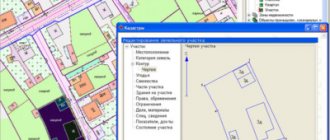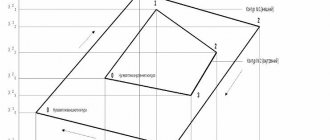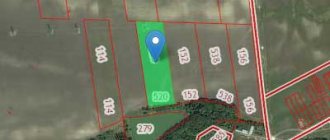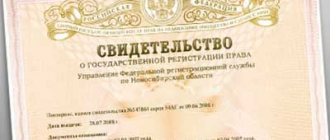Portal of the Federal Tax Service
You can find out the land tax by cadastral number on the portal of the Federal Tax Service (www.nalog.ru). Payers are offered a tax calculator directly linked to the Rosreestr database (www.rosreestr.ru). You need to fill out a step-by-step form and the tax value will be determined here.
Every citizen can use the portal and tax calculator, both to monitor the timely payment and amount of taxes on their own real estate, and to obtain other necessary information. All information on real estate objects is linked to unique cadastral numbers.
Actually, the Roseestr database is a web resource www.kadastrmapp.ru, where you can view the cadastral value and obtain information in a graphical dialogue form on maps:
In addition to graphics, information is also provided in text form, when indicating the real address of the object or its cadastral code. All dialogue options are clearly connected to each other, and the indication of the necessary information flows easily from one type of presentation to another.
A characteristic feature of all dialogs is the automatic “intelligent” auto-filling of the actual fields of the initial data entry forms, that is, with insufficient information, the user receives the exact name of the region, locality, street, house and even available apartment numbers.
All graphical options for presenting this important information are convenient not only for their technical design, but also show the boundaries of cadastral plots, shapes of plots and position in relation to all adjacent real estate objects.
Having selected the desired object, you can obtain information on the land plot and order documents. Information is provided on a paid basis; various payment options for services are allowed. All stages of obtaining information are commented on, up to the provision of samples of received documents for each item.
The Federal Tax Service portal provides a wide range of useful information:
- land price, area size;
- technical characteristics (passport data);
- extracts and certificates of encumbrances;
- information about property rights;
- extracts and the possibility of obtaining documents with a seal.
One of the practical applications of the portal is to quickly obtain important information, for example, the purpose of the object, area, information about the owners, the presence of restrictions and encumbrances (pledge, mortgage). This can be useful when making transactions, issuing loans, and checking the accuracy of data.
Documents, acts of legislation, recommendations, and explanations on a range of taxation issues in the Russian Federation are also posted here in a systematic form.
In addition to issues of taxation itself, statistical information on the registration of enterprises is provided, issues of creating enterprises, and improving the Federal taxation system are discussed.
How to check tax debt on the Federal Tax Service website
You can find out about the presence or absence of debts on land fees on the tax service website. To do this, you need to obtain access to the taxpayer’s personal account. This procedure includes a visit to the district office of the Federal Tax Service, where the citizen receives a login and password to enter the site.
The personal account reflects the objects owned by the citizen, as well as their cadastral number and value. The website allows you to check the status of land tax payments: the amount of charges, when and in what amount the payment was made, whether there is a debt or overpayment.
Calculation of land tax
The essential point is that land tax is regulated by federal laws and local regulations. For legal entities that are required to independently calculate taxes, including advance taxes, this constitutes a certain complicated algorithm.
Since not all municipalities update information in their area of responsibility in a timely manner, and when they do, they do not always adhere to the general policy of Rosreestr, taxpayers have to constantly monitor the situation.
Actually, this is a problem of a certain significance, that not all sections of the Rosreestr are filled out. In addition, local municipalities usually update information on maximum values, without consistently adhering to the recommendations of Rosreestr.
We recommend that you read:
Selling an apartment and buying an apartment in the same tax period
However, for business purposes and assessing certain prospects, this is not so much a problem as a reason and reason to optimize the business. In addition, tax rates for individuals and legal entities are the same, and by acquiring ownership of a large plot of land, a legal entity also acquires an adequate tax burden.
The law defines the obligation to calculate tax only for legal entities. Only they are obliged to carry out the calculations independently; citizens receive appropriate notifications from the divisions of the Federal Tax Service for their real estate properties.
In all cases, it is advisable for everyone to have an accurate understanding of how the calculation is performed.
First you need to find out:
- allow local authorities to pay tax in advance (legal entity);
- availability of the right to benefits;
- tax rate;
- cadastral value of the plot.
The simplest case: land tax based on cadastral value is determined as the product of the cadastral value and the tax rate. The cadastral value is taken at the beginning of the year for which the tax is calculated.
In this case, the first part of the expression is defined as a measure of use of the site, that is, as the cost divided by the number of full months of use. The number of months of use is rounded up.
The second part of the expression (tax rate) depends on local authorities, but it cannot be more than that determined by the Tax Code of Russia and classified by type of land.
An important point is the likelihood of paying taxes to several budgets. This situation arises when the site is located in the territories of several municipalities. As always, in such cases certain difficulties arise: rates may differ, and historically it is not possible to change the state of things (the boundaries of the site).
The procedure for calculating land tax
The basis for calculating the payment is the cadastral value of the site, which is determined by the registration authority. It is reflected in the register, as well as in the cadastral passport. The amount is calculated by multiplying the cadastral value by a tax coefficient, which has two values: 0.3% or 1.5%.
A coefficient of 0.3% is used to calculate the contribution for plots that:
- intended for growing a garden or vegetable garden;
- located under apartment buildings;
- used for agriculture;
- are in the possession of state security services;
- busy with utility networks.
In other cases, a coefficient of 1.5% is used.
IMPORTANT! Rates are determined by the Tax Code, but municipalities can change them by applying regional coefficients.
To calculate the amount of the contribution for the reporting year, it is necessary to multiply the cadastral value by 0.3 or 1.5, as well as by the rate established in a particular region.
Tax rates, example
The upper level of rates is determined by federal legislation, comprehensive information on which is contained in the portal of the Federal Tax Service (www.nalog.ru). The information is grouped into sections, by directions, commented on and equipped with a navigation system.
The main group of lands is agriculture, housing stock, housing and communal services infrastructure, personal and dacha farming, the needs of the state defense complex - maximum rate of 0.3%, all other lands - maximum rate of 1.5%.
Municipal authorities have the right to adopt differentiated values based on:
- by land category;
- on the actual territorial location of the sites;
- for permitted use.
At the same time, the peculiarities of the intersection of lands with nature reserves and botanical gardens (exempt from land tax) are taken into account. It is taken into account that some institutions are also exempt from tax.
Example. There is a plot worth 10`000`000 rubles. Its 20% are located in one territory, the remaining 80% are in another. In the first territory the tax rate is 0.1%, in the other - 0.2%. Therefore, the first 2`000`000 rubles provide a tax of 2`000 for the first territory, and the remaining 8`000`000 rubles replenish the budget of the second territory by 16`000 rubles.
In total, the owner of this plot will pay 18,000 rubles.
Procedure for obtaining information
The cadastral number does not change over time. To obtain it, you need to contact the Cadastral Service.
To obtain information about the amount of land tax by cadastral number, you need to use the calculator on the Federal Tax Service website, indicating:
- cadastral number;
- time of ownership of the site;
- tax benefit information;
- tax deduction;
- size of the plot (share owned by the requested person).
After filling in the required fields, the accrued fee will be indicated. This procedure is completely free.
About the tax amount
The tariff for a land plot can be found out online through the State Services portal or by contacting the Tax Inspectorate. On the website, after indicating the cadastral number, the area and cadastral value of the plot are displayed. To calculate the tax, you need to check the size of the rate and the possible availability of benefits (individually determined by the local council) on the website of the local Federal Tax Service.
To check whether the Federal Tax Service has calculated the tax correctly, you need to clarify:
- whether benefits, if any, are taken into account;
- what is the duration of ownership of the plot and what is the share of ownership.
Using the Federal Tax Service calculator, calculate deductions and compare them with the amount requested by the tax inspector. If there are discrepancies, contact the Tax Service or then go to court if the issue cannot be resolved.
About debt
Information is available to individuals on the State Services website. To view current information (according to Rosreestr), you must select All services/Electronic services/Land tax calculator/Land (tax type). Next, the year for which the tax is paid, the share of the land (belonging to the person making the request), and the number of months of ownership are specified. Then indicate the rate (approved for the region) and information about possible tax deductions. If the owner has benefits, they are also listed in the column. After filling in the fields, the database displays the total amount that needs to be paid (the current debt at the moment).
Tax calculator
On the portal of the Federal Tax Service, access to the tax calculator can be obtained through the portal’s search tools or directly through the “Taxation of Real Estate” section.
We recommend that you read:
Registration of a tax deduction when purchasing an apartment through State Services
To perform the calculation, you must fill out the form:
- Select the type of tax “Land tax”.
- Determine the tax period (2015, 2021 or 2017).
- Indicate the cadastral value.
- Indicate the area of the object.
- Indicate the share in the right (if sole ownership is 1).
- Holding period (for example, year – 12).
- If there is a tax deduction.
- Tax rate (usually 0.1).
- If there are benefits.
After completing all these steps, the calculation is performed and the total tax amount will be displayed on the screen.
To clarify the cadastral value, you should visit the Rosreestr portal. The cadastral number provides comprehensive information on any object included in the current cadastre.
The portal is not the only source of this information; you can obtain this information from the tax office, the municipality, or another authorized government body, but this will take much more personal time.
It should be borne in mind that the legislative bodies of federal cities can increase the amount of tax deductions within the limits of their competence and territory.
To clarify the benefits, deductions and tax rates in force in a particular region of the Russian Federation, you should contact the relevant municipality, branch of the Federal Tax System.
What parameters does the cadastral value consist of?
- location of the real estate property;
- characteristics;
- square;
- VRI;
- special purpose;
- possibility of improvement, etc.
Most owners are interested in the low cadastral value of the property. This is due to the fact that it acts as a basis for taxation. The characteristics of the property, including the shortcomings of the property, can reduce or increase the cadastral value.
There are some nuances in checking the cadastral value of individual real estate properties. For example, the frequency of checking the cadastral price of a land plot is set by local authorities once every three years. But in practice, the cadastral price is revised once every 5 years. Local authorities try not to violate the regulations, since in the event of errors or inaccuracies, the issue of determining the cadastral price of a property may fall under federal jurisdiction. But a revision of the cadastral value is possible. But there must be good reasons for this. The owner must explain why he requires changing this indicator outside the designated period. For example, an extraordinary inspection is carried out due to circumstances that may affect the value of the real estate property. For example, this is due to the construction of a new infrastructure facility (increase in cost) or natural, man-made accidents (decrease).
Tax benefits
Certain categories of owners may qualify for benefits:
- heroes;
- veterans and persons equivalent to them;
- disabled people of certain groups;
- other categories of citizens.
Persons who provide documents indicating their membership in the specified groups provided for by current legislation can count on a reduction in the tax base.
Local category of benefits - benefits of constituent entities of the Russian Federation and cities of federal significance. Local regulations may provide benefits up to the complete abolition of the tax, but on the condition that the subject of the Russian Federation itself, which provided the benefit, will contribute the difference to the state budget at its own expense.
For example, some organizations of the city of Moscow in relation to the sites they occupy.
Condition - such areas are located on the territories of municipalities that are part of the territory of Moscow:
- 43% – companies with at least 70% of total income from their own products;
- 23% – sanitary and resort organizations according to the list of the Government of the Russian Federation;
- 20% – organizations engaged in the construction or reconstruction of sports facilities.
Other federal cities, as well as some regions of Russia, do the same.
Tax base
The cadastral value of a plot is the tax base for determining the amount of the levy. The amount of payment transferred to the state is of interest to citizens and organizations. The tax base is valid for each of the land plots.
Art. 391 of the Tax Code of the Russian Federation applies the rules for calculating cadastral value as the basis for calculating taxes:
- a decrease or increase in the indicator due to changes in the characteristics of the land, both qualitative and quantitative, occurs after making a correction in the Unified State Register of Real Estate;
- when correcting an error in the cadastral value of a land plot by a court decision, in connection with a revision of the amount of tax, the information is taken into account when determining the tax base from the date of commencement of their application for tax purposes.
How to find out the tax on a land plot by cadastral number
Checking land tax debt by cadastral number. Land tax is paid by all land owners, regardless of whether it is used. Tax liability arises after state registration of the right to the plot. How to find out the tax amount? Will I need a cadastral number to verify debt?
How to find out land tax by cadastral number
Land tax belongs to the category of local taxes established on the territory of municipalities of the country. The tax is largely regulated by the provisions of the Tax Code of the Russian Federation, Chapter 31. In addition, certain provisions are enshrined in the Land Code and documents approved by local authorities.
Tax fees are paid by all legal entities and individuals, as well as individual entrepreneurs, regardless of whether the land plot is used, whether the plot belongs to one owner or in shares with others. This procedure is provided at the federal level.
All tax payments are transferred to local budgets at the location of the taxable plot.
When you might need to do your own tax audit
The amount of the tax under consideration directly depends on the cadastral value of the object; it is the tax base. When calculating the total contribution amount, the value as of January 1 of the year, the current tax period, will be valid.
It would be advisable to find out the amount of debt or arrears even if the land tax has already been transferred. The cause of unwanted problems with tax authorities may be:
In addition to graphics, information is also provided in text form, when indicating the real address of the object or its cadastral code. All dialogue options are clearly connected to each other, and the indication of the necessary information flows easily from one type of presentation to another.
A characteristic feature of all dialogs is the automatic “intelligent” auto-filling of the actual fields of the initial data entry forms, that is, with insufficient information, the user receives the exact name of the region, locality, street, house and even available apartment numbers.
All graphical options for presenting this important information are convenient not only for their technical design, but also show the boundaries of cadastral plots, shapes of plots and position in relation to all adjacent real estate objects.
Having selected the desired object, you can obtain information on the land plot and order documents. Information is provided on a paid basis; various payment options for services are allowed. All stages of obtaining information are commented on, up to the provision of samples of received documents for each item.
The Federal Tax Service portal provides a wide range of useful information:
- land price, area size;
- technical characteristics (passport data);
- extracts and certificates of encumbrances;
- information about property rights;
- extracts and the possibility of obtaining documents with a seal.
One of the practical applications of the portal is to quickly obtain important information, for example, the purpose of the object, area, information about the owners, the presence of restrictions and encumbrances (pledge, mortgage). This can be useful when making transactions, issuing loans, and checking the accuracy of data.
Documents, acts of legislation, recommendations, and explanations on a range of taxation issues in the Russian Federation are also posted here in a systematic form.
In addition to issues of taxation itself, statistical information on the registration of enterprises is provided, issues of creating enterprises, and improving the Federal taxation system are discussed.
Calculation of land tax
The essential point is that land tax is regulated by federal laws and local regulations. For legal entities that are required to independently calculate taxes, including advance taxes, this constitutes a certain complicated algorithm.
Since not all municipalities update information in their area of responsibility in a timely manner, and when they do, they do not always adhere to the general policy of Rosreestr, taxpayers have to constantly monitor the situation.
Actually, this is a problem of a certain significance, that not all sections of the Rosreestr are filled out. In addition, local municipalities usually update information on maximum values, without consistently adhering to the recommendations of Rosreestr.
However, for business purposes and assessing certain prospects, this is not so much a problem as a reason and reason to optimize the business. In addition, tax rates for individuals and legal entities are the same, and by acquiring ownership of a large plot of land, a legal entity also acquires an adequate tax burden.
The law defines the obligation to calculate tax only for legal entities. Only they are obliged to carry out the calculations independently; citizens receive appropriate notifications from the divisions of the Federal Tax Service for their real estate properties.
In all cases, it is advisable for everyone to have an accurate understanding of how the calculation is performed.
First you need to find out:
- allow local authorities to pay tax in advance (legal entity);
- availability of the right to benefits;
- tax rate;
- cadastral value of the plot.
The simplest case: land tax based on cadastral value is determined as the product of the cadastral value and the tax rate. The cadastral value is taken at the beginning of the year for which the tax is calculated.
In this case, the first part of the expression is defined as a measure of use of the site, that is, as the cost divided by the number of full months of use. The number of months of use is rounded up.
The second part of the expression (tax rate) depends on local authorities, but it cannot be more than that determined by the Tax Code of Russia and classified by type of land.
An important point is the likelihood of paying taxes to several budgets. This situation arises when the site is located in the territories of several municipalities. As always, in such cases certain difficulties arise: rates may differ, and historically it is not possible to change the state of things (the boundaries of the site).
Tax rates, example
The upper level of rates is determined by federal legislation, comprehensive information on which is contained in the portal of the Federal Tax Service (www.nalog.ru). The information is grouped into sections, by directions, commented on and equipped with a navigation system.
The main group of lands is agriculture, housing stock, housing and communal services infrastructure, personal and dacha farming, the needs of the state defense complex - maximum rate of 0.3%, all other lands - maximum rate of 1.5%.
Municipal authorities have the right to adopt differentiated values based on:
- by land category;
- on the actual territorial location of the sites;
- for permitted use.
At the same time, the peculiarities of the intersection of lands with nature reserves and botanical gardens (exempt from land tax) are taken into account. It is taken into account that some institutions are also exempt from tax.
Example. There is a plot worth 10`000`000 rubles. Its 20% are located in one territory, the remaining 80% in another. In the first territory the tax rate is 0.1%, in the other - 0.2%. Therefore, the first 2`000`000 rubles provide a tax of 2`000 for the first territory, and the remaining 8`000`000 rubles replenish the budget of the second territory by 16`000 rubles.
In total, the owner of this plot will pay 18,000 rubles.
Tax calculator
On the portal of the Federal Tax Service, access to the tax calculator can be obtained through the portal’s search tools or directly through the “Taxation of Real Estate” section.
To perform the calculation, you must fill out the form:
- Select the type of tax “Land tax”.
- Determine the tax period (2015, 2021 or 2017).
- Indicate the cadastral value.
- Indicate the area of the object.
- Indicate the share in the right (if sole ownership is 1).
- Holding period (for example, year – 12).
- If there is a tax deduction.
- Tax rate (usually 0.1).
- If there are benefits.
After completing all these steps, the calculation is performed and the total tax amount will be displayed on the screen.
To clarify the cadastral value, you should visit the Rosreestr portal. The cadastral number provides comprehensive information on any object included in the current cadastre.
The portal is not the only source of this information; you can obtain this information from the tax office, the municipality, or another authorized government body, but this will take much more personal time.
It should be borne in mind that the legislative bodies of federal cities can increase the amount of tax deductions within the limits of their competence and territory.
To clarify the benefits, deductions and tax rates in force in a particular region of the Russian Federation, you should contact the relevant municipality, branch of the Federal Tax System.
Tax benefits
Certain categories of owners may qualify for benefits:
- heroes;
- veterans and persons equivalent to them;
- disabled people of certain groups;
- other categories of citizens.
Persons who provide documents indicating their membership in the specified groups provided for by current legislation can count on a reduction in the tax base.
Local category of benefits - benefits of constituent entities of the Russian Federation and cities of federal significance. Local regulations may provide benefits up to the complete abolition of the tax, but on the condition that the subject of the Russian Federation itself, which provided the benefit, will contribute the difference to the state budget at its own expense.
For example, some organizations of the city of Moscow in relation to the sites they occupy.
Condition - such areas are located on the territories of municipalities that are part of the territory of Moscow:
- 43% - companies with at least 70% of total income from their own products;
- 23% - sanitary and resort organizations according to the list of the Government of the Russian Federation;
- 20% are organizations engaged in the construction or reconstruction of sports facilities.
Other federal cities, as well as some regions of Russia, do the same.
Cadastral number
Real estate must, in accordance with the procedure established by law, undergo the procedure of mandatory state registration with Rosreestr. The initiative comes from the owner, but this initiative is mandatory: as long as there is no information in the cadastre, there is no right of disposal.
The right to own, use and dispose of property appears only when the property receives its own unique number, which is then used:
- in the cadastral passport;
- in all technical and legal documents.
The cadastre is a complex information mechanism, which has now been brought to effective public use and is a platform for interaction between various government agencies, as well as owners in the process of implementing legal interaction in the field of real estate. The structure of the cadastral number consists of four digits:
- district(00);
- district (00:00);
- quarter(00:00:000000);
- land plot (00:00:000000:000).
Result: 00:00:000000:000 - this is the cadastral number.
This number is always unique, and once assigned, it is never assigned to another object.
Under the cadastral number, all information on the land plot, house, land survey boundaries, areas, all changes, data on rights, owners, and so on is stored - this is “real” evidence of the existence of a real property. At the same time, implementation in the format of a distributed information system allows you to reliably and quickly obtain the necessary information in its current state.
Source: https://ZhiloePravo.com/nalogi/kak-uznat-kadastrovomu-nomeru.html







